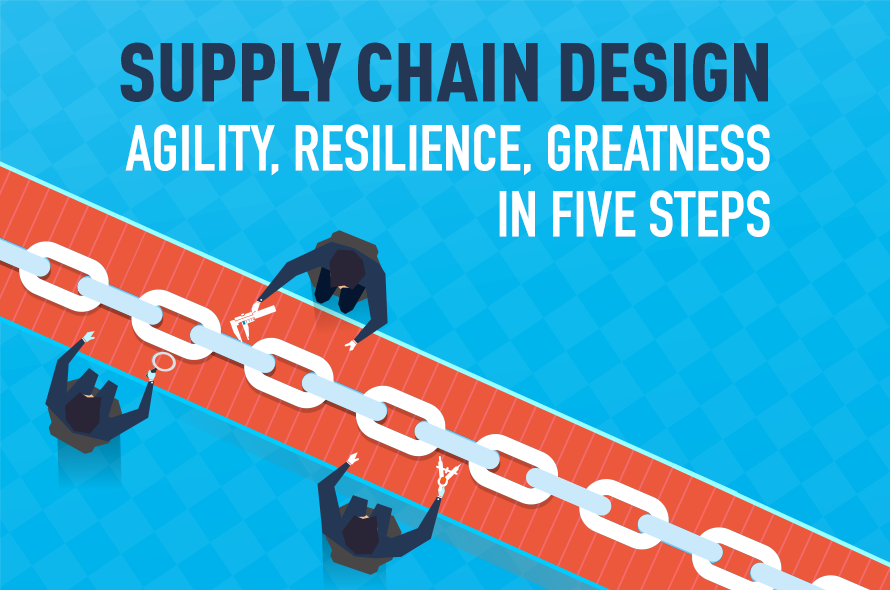Introduction
Agile, flexible, resilient – today’s supply chains must be all this and more to be able to respond swiftly to changes in business and market dynamics. But how do you build and sustain such supply chains? How to ensure they deliver today and tomorrow? The answer lies in supply chain network design.
Many companies establish a baseline when they develop their initial supply chain model. This creates a “living” model that need only be modified as business conditions change. The key, however, is to build upon that model as times and conditions change. This exclusive GEP white paper will discuss how to design a supply chain model, defining its parameters and capabilities to establish a “living” model that can be modified and optimized as business and market conditions change.
The new global reality for most companies is one of volatility, complexity and rapid change. Even world-class supply chain networks struggle to evolve as sourcing adapts to market changes, product line performance varies, business demographics change faster, and companies integrate at a rapid pace.
The networks of some of the world’s best recognized firms have evolved from a sequence of historical happenstance rather than thoughtful design and planning. Analysts claim that 80 percent of supply chain cost is predetermined in the design of the product and supply chain network alone, so ignoring network design can prove to be very costly in the long term. A simple mapping exercise of a supply chain network and its flows, timelines, current costs and revenues often can spark unexpected and disturbing questions, such as:
- Why is optimizing our manufacturing capacity while meeting customer promises so difficult?
- Why do we have so many warehouses and stocking locations and why are they located where they are?
- Why do we have so much inventory and why isn’t it positioned better to meet objectives?
- How did our order lead response times grow so long?
- Why are our freight costs so high?
- Our risks look so much bigger when we map them. When and why did we grow into this risky situation?
- Is our cash flow being impacted negatively by our current network design?
In addition, there are questions about total cost of ownership, sustainability and, if applicable, performance following a merger or acquisition.
Appreciation for supply chain review and design has increased in recent years and has been recognized by some marketing-leading companies as an effective approach to managing rapid global business and economic shifts changes and the challenges that they entail. However, many companies consider supply chain design to be a project run once every three to five years, or even worse, a one-time event not to be adjusted, tweaked or repeated as conditions change.
What are the benefits of regular supply chain design?
Supply chain design allows enterprises to model, simulate, visualize and optimize their supply chain to make major improvements in total costs, service, speed-to-market, flexibility and supply chain risk management mitigation. Key benefits include:
- Identification of areas for optimization and potential cost savings
- Inventory and working capital reduction
- Transportation cost and transit time reduction
- Reduction in network fixed costs (e.g. facilities, equipment) and supply chain variable costs (e.g. labor, handling, 3PL costs)
- Optimized service levels, delivery dates and customer satisfaction
- Process and cost transparency across the entire network
- Increased time efficiency within the business organization
- As a basis for internal benchmarking, the model would be one place where all the supply chain capabilities/ costs are cataloged and provide performance visibility of the overall network
Establishing a baseline by developing the initial supply chain model will be the most time-consuming activity in a company’s network design journey. Designing the model, defining the parameters and capabilities, and collecting the relevant supply chain data requires much effort, but this establishes a “living” model that need only be modified as business conditions change. Once this baseline model has been established, modeling changes in the supply chain becomes a much easier task and makes “what-if” analysis more cost efficient to the organization.
For example, if a company acquires a smaller firm, the acquisition’s manufacturing and warehousing sites can be integrated into the baseline model. This is much easier to do than building a new model from scratch. Having an existing design/model allows for proactive what-if analysis, allowing the company to cost-effectively model any proposed changes and determine the impact on the new overall supply chain more easily. Not having a “living” model/design in place makes those new analyses expensive, inefficient and laborious.
Why don’t one-time or infrequent design projects generate the best long-term results?
Attempting one-off or infrequent optimization projects to determine the design of an organization’s supply chain is likely to fail for several reasons. For one, change is happening at an ever quickening pace. Markets, customers, geo-politics, raw materials, labor, even climate and weather fluctuate from year to year, often from quarter to quarter. A model optimized at a point-in-time today will not last long.
Without a living supply chain design (or model) or internal supply chain modeling capability, there can be no iterative improvement process that refines and makes the inputs (data and assumptions), optimization processes and end results more consistent. The more often the supply chain model is updated to reflect current realities, the better and more accurate the supply chain design outcomes will be over time.
Additionally, a one-off project can suffer from an inconsistent and suboptimal team. With no ongoing, long-term responsibility to maintain the accuracy of a supply chain model, design team members may be poorly chosen or lack long-term commitment to the results. If projects are infrequent, changing analysts can cause the need to constantly relearn and make it much more difficult and costly to apply the learnings from the last project.
Finally, key learning from previous — but infrequent — design alterations often require additional time to study and explore problems and changes. Project team members who are “short-timers” likely will not have the time to capture and recommend improvements.
Why make supply chain design a regular process?
Rapid changes in global economic and geo-politcal conditions are causing upheavals in global production and distribution. Slower world GDP growth is causing lower than expected global demand. With China’s recent slowdown and Chinese labor rates increasing, the center of mass for global manufacturing is shifting. Nearshoring and reshoring of manufacturing to locations closer to the point of consumption may continue, leading to rapid shifts in global product flows.
Forward-thinking companies are placing a premium on supply chain agility and are rethinking and reexamining their supply chain networks much more frequently. New, innovative technology for supply chain design is making this easier, enabling modeling to include more business functions and produce much more detailed levels of analysis. Some firms now update their models several times throughout the year as environmental changes warrant. Supply chain design is now becoming a core process and a critical business function with many of the world’s leading supply chains.
Supply chain design allows sourcing decisions to be modeled to see how changes will affect the business
New sourcing options can carry unique risks that may be overlooked or minimized when reviewing the attractive cost-savings potential of such options. When negotiating with suppliers, should you accept cost reductions instead of lead time reductions? Fast replenishment versus Vendor Managed Inventory (VMI) options? Reducing quality standards to ensure adequate and consistent supply? What works best for your organization and your customers, and how do you quantify the trade-offs in each option?
Frequent supply chain design enables companies to model the entire supply chain network to determine the effects of regular sourcing decisions (“what-if” scenarios) and empowers optimal supplier selection and category management strategies.
How to institutionalize supply chain design?
Here are five ways to elevate supply chain design from a project to a core business process:
Establish a permanent supply chain design center that is empowered to work across business units.
A team doesn’t have to be large, just big enough to retain lessons learned from previous projects and improve the cycle of regular projects. Start recruiting early to find those experienced in design work and also in your industry. Consulting firms always can supplement the team if the workload or number of projects increases unexpectedly and can even act as outsourced center for short term or long term, depending on your business needs.
- Establish the frequency of supply chain design and any trigger points to indicate when you should plan to remodel your supply chain.
- A full review typically should be performed every one to three years, depending on market and industry changes. Many companies now are reviewing and updating their full models annually and others, in very volatile environments, several times throughout the year.
- Some firms run certain specific models, such as Multi-Echelon Inventory Optimization (MEIO) on a quarterly basis. MEIO attempts to deliver the best possible trade-off between service levels and inventory for each SKU at each inventory stocking location across the different tiers or “echelons” of the enterprise’s distribution network. Adjusting inventory levels more frequently across all echelons can immediately lower the total supply chain inventory cost and improve customer service.
- There are critical trigger points signifying when to reengage in supply chain design, including:
- Changes in business strategy, such as targeting new market opportunities
- Major business expansion, such as a new-country entry, merger or acquisition
- Key political and economic policy changes that impact the markets and industries in which a company operates
- The need for contingency planning to guard against failure resulting from unpredictable changes in the supply chain network (energy shortages, strikes, weather and natural disasters, product recalls, acts of violence, etc.)
- Strategic sourcing events where major supply network changes are being considered, such as number and types of suppliers, supplier location, supplier product/service mixes in award scenarios
- Talk to other companies that are at different stages of supply chain design and resource development. Join supply chain design and network optimization forums and associations. Talk with others in network design user groups. Ask what has worked and what has not and for any recommendations or lessons learned.
- Consult with third parties if you remain unsure which technology platform to use or are not ready to make the commitment to buying software, but are ready to commit regular projects. Talk with your consulting partners and review any preferred tools they use. Consulting partners can help get projects under your belt quickly, especially if you do not have the resources, in-house expertise or software platform.
- Reach out for help when needed. Between a well-developed network, a trusted consulting partner and a chosen software vendor, there is no reason to flounder. Be willing to ask other professionals for help — you’ll be surprised how many will share valuable information and ideas. If quality and experienced outside help is really needed, be willing to pay reasonably for it and continue to move forward. Don’t stall out and don’t stop at just one supply chain design project; keep tweaking.
Conclusion
In a rapidly changing global business and economic environment, successful companies are taking advantage of technology to focus more critical attention to supply chain agility and reexamining their supply chain networks frequently. They are establishing “living” models that include more business functions and detailed analysis, often updating their models multiple times each year.
Supply chain design should be, and is for many, a core process and a critical business function. By creating a dynamic supply chain model, enterprises can ensure that their supply chains deliver on business expectations today and tomorrow.

